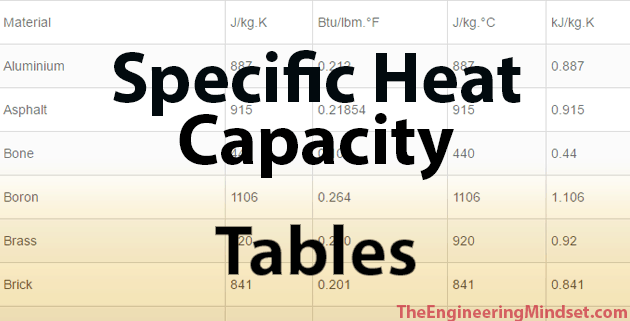

An additional factor for all types of specific heat capacities (including molar specific heats) then further reflects degrees of freedom available to the atoms composing the substance, at various temperatures.įor most liquids, the volumetric heat capacity is narrower, for example octane at 1.64 MJ⋅K −1⋅m −3 or ethanol at 1.9. If all atoms were the same size, molar and volumetric heat capacity would be proportional and differ by only a single constant reflecting ratios of the atomic molar volume of materials (their atomic density). Atoms vary greatly in density, with the heaviest often being more dense, and thus are closer to taking up the same average volume in solids than their mass alone would predict. This is mostly due to differences in the physical size of atoms. The volumetric heat capacity of solid materials at room temperatures and above varies widely, from about 1.2 MJ⋅K −1⋅m −3 (for example bismuth ) to 3.4 MJ⋅K −1⋅m −3 (for example iron ).

This quantity was proportional to the heat capacity per atomic weight (or per molar mass), which suggested that it is the heat capacity per atom (not per unit of volume) which is closest to being a constant in solids.Įventually it became clear that heat capacities per particle for all substances in all states are the same, to within a factor of two, so long as temperatures are not in the cryogenic range. In 1819 they found that volumetric heat capacities were not quite constant, but that the most constant quantity was the heat capacity of solids adjusted by the presumed weight of the atoms of the substance, as defined by Dalton (the Dulong–Petit law). This amounted to a prediction that volumetric heat capacity in solids would be constant. Historyĭulong and Petit predicted in 1818 that the product of solid substance density and specific heat capacity (ρc p) would be constant for all solids. Therefore, the word "volumetric" should always be used for this quantity. International standards now recommend that "specific heat capacity" always refer to capacity per unit of mass. This quantity is used almost exclusively for liquids and solids, since for gases it may be confused with the "specific heat capacity at constant volume", which generally has very different values. Its SI unit is joule per kelvin per cubic meter (J⋅K −1⋅m −3). The volumetric heat capacity is defined as s ( T ) = C ( T ) V ( T ) = 1 V ( T ) lim Δ T → 0 Δ Q ( T ) Δ T. If the amount of substance is taken to be the number of moles in the sample (as is sometimes done in chemistry), one gets the molar heat capacity (whose SI unit is joule per kelvin per mole, J⋅K −1⋅mol −1). The volumetric heat capacity of a substance, especially a gas, may be significantly higher when it is allowed to expand as it is heated (volumetric heat capacity at constant pressure) than when is heated in a closed vessel that prevents expansion (volumetric heat capacity at constant volume). While the substance is undergoing a phase transition, such as melting or boiling, its volumetric heat capacity is technically infinite, because the heat goes into changing its state rather than raising its temperature. The volumetric heat capacity often varies with temperature, and is different for each state of matter. This quantity may be convenient for materials that are commonly measured by volume rather than mass, as is often the case in engineering and other technical disciplines. The volumetric heat capacity can also be expressed as the specific heat capacity (heat capacity per unit of mass, in J⋅K −1⋅ kg −1) times the density of the substance (in kg/ L, or g/ mL). The SI unit of volumetric heat capacity is joule per kelvin per cubic meter, J⋅K −1⋅m −3. It is the amount of energy that must be added, in the form of heat, to one unit of volume of the material in order to cause an increase of one unit in its temperature. The volumetric heat capacity of a material is the heat capacity of a sample of the substance divided by the volume of the sample. For volumetric heats of particular substances, see Table of specific heat capacities.


 0 kommentar(er)
0 kommentar(er)
